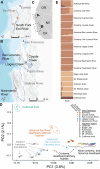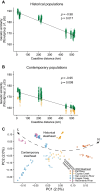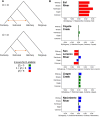Recent Adaptation in a Threatened Salmonid Revealed by Museum Genomics
- PMID: 40891211
- PMCID: PMC12421487
- DOI: 10.1111/mec.70063
Recent Adaptation in a Threatened Salmonid Revealed by Museum Genomics
Abstract
Steelhead/rainbow trout (Oncorhynchus mykiss) is an imperilled salmonid with two main life history strategies: migrate to the ocean or remain in freshwater. Domesticated hatchery forms of this species have been stocked into almost all California waterways, possibly resulting in introgression into natural populations and altered population structure. We compared whole-genome sequence data from contemporary populations against a set of museum population samples of steelhead from the same locations that were collected prior to most hatchery stocking. We observed minimal introgression and few steelhead-hatchery trout hybrids despite a century of extensive stocking. Our historical data show signals of introgression with a sister species and indications of an early hatchery facility. Finally, we found that migration-associated haplotypes have become less frequent over time, a likely adaptation to decreased opportunities for migration. Since contemporary migration-associated haplotype frequencies have been used to guide species management, we consider this to be a rare example of shifting baseline syndrome that has been validated with historical data. We suggest cautious optimism that a century of hatchery stocking has had minimal impact on California steelhead population genetic structure, but we note that continued shifts in life history may lead to further declines in the ocean-going form of the species.
Keywords: adaptation; conservation genetics; fish; hybridization; natural selection and contemporary evolution; population genetics – empirical.
Published 2025. This article is a U.S. Government work and is in the public domain in the USA. Molecular Ecology published by John Wiley & Sons Ltd.
Conflict of interest statement
The authors declare no conflicts of interest.
Figures




References
-
- Abadía‐Cardoso, A. , Brodsky A., Cavallo B., et al. 2019. “Anadromy Redux? Genetic Analysis to Inform Development of an Indigenous American River Steelhead Broodstock.” Journal of Fish and Wildlife Management 10, no. 1: 137–147.
-
- Abadía‐Cardoso, A. , Pearse D. E., Jacobson S., et al. 2016. “Population Genetic Structure and Ancestry of Steelhead/Rainbow Trout (<styled-content style="fixed-case"> Oncorhynchus mykiss </styled-content>) at the Extreme Southern Edge of Their Range in North America.” Conservation Genetics 17: 675–689.
-
- Allendorf, F. W. , Leary R. F., Spruell P., and Wenburg J. K.. 2001. “The Problems With Hybrids: Setting Conservation Guidelines.” Trends in Ecology & Evolution 16, no. 11: 613–622.
MeSH terms
Grants and funding
LinkOut - more resources
Full Text Sources

